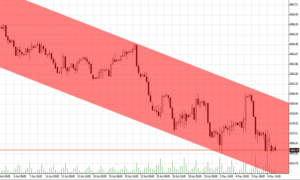

09.05.2022 – Not good news for the bulls: According to Goldman Sachs, the stock market will literally bleed out in the near future. However, the stock market will repeatedly resist the decline with violent, short rallies and short squeezes. At least that’s what one expert says, who has already been right twice recently.
Tony Pasquariello, head of hedge fund sales at Goldman Sachs, commented that in the meantime the negative momentum had been curbed for the time being because of the latest, not really frightening meeting of the Federal Reserve. Nevertheless, the S&P had returned to the end of the trading range that had already defined the past three months. And we add: In the four-hour chart of the S&P 500, the downtrend of the SPX is clearly visible – in which there were countermoves to the upside again and again. Most recently, this was the case at the latest Fed meeting. Which brings us back to Pasquariello’s thesis.

Source: Bernstein Bank GmbH
Once again, the Golmann sent a warning to the bulls in the financial world. Yesterday he wrote: “the more time we spend near the lower goal post, the more I question whether the state of the market is a genuine range trade … or a steady bleed to lower lows that’s interrupted, on occasion, by vicious short squeezes.” The expert did not give a clear time frame, but in previous speaking engagements he spoke of several bearish weeks. As is often the case, it depends on the state of the economy.
Buy the dips – sell the rips
For the bulls, Pasquariello now warned that the Fed would have to tighten aggressively because of inflation, which would slow down the economy. He also told the bears that the strength of the labor market is strong enough to prevent a recession. And for now, here’s the specific recommended action for all traders: “buy dips below 4200, sell rips over 4500 (and, if I’m going to be wrong, it’s more likely to the downside than to the upside).” We translate: This mentioned lower limit is likely to be broken more easily than the upper limit. And thus there seems to be more opportunities on the short side.
He was right
Pasquariello had already been right at the end of March. Against the prevailing trend, he had predicted that the party would come to an end. And he still warned of a bear market squeeze. A few days later, he wrote of recession signals that were out in the open for all to see. And in mid-April, Pasquariello stated that the best days were behind us. Again, he was right. And this time?
Our conclusion: This assessment actually has some merit. Inflation is raging, central banks have to withdraw capital from the market. But they have to be careful not to unleash a deflationary recession all of a sudden. And even fiscal policy is powerless against price increases in the supply chain triggered by Covid or the Ukraine war. In this clash of hopes and fears, the stock market will remain volatile. Bernstein Bank wishes successful trades and investments!
Important Notes on This Publication:
The content of this publication is for general information purposes only. In this context, it is neither an individual investment recommendation or advice nor an offer to purchase or sell securities or other financial products. The content in question and all the information contained therein do not in any way replace individual investor- or investment-oriented advice. No reliable forecast or indication for the future is possible with respect to any presentation or information on the present or past performance of the relevant underlying assets. All information and data presented in this publication are based on reliable sources. However, Bernstein Bank does not guarantee that the information and data contained in this publication is up-to-date, correct and complete. Securities traded on the financial markets are subject to price fluctuations. A contract for difference (CFD) is also a financial instrument with leverage effect. Against this backdrop, CFD trading involves a high risk up to the point of total loss and may not be suitable for all investors. Therefore, make sure that you have fully understood all the correlating risks. If necessary, ask for independent advice. CFDs are complex instruments and are associated with the high risk of losing money quickly because of the leverage effect. 68% of retail investor accounts lose money trading CFD with this provider. You should consider whether you understand how CFD work and whether you can afford to take the high risk of losing your money.7
